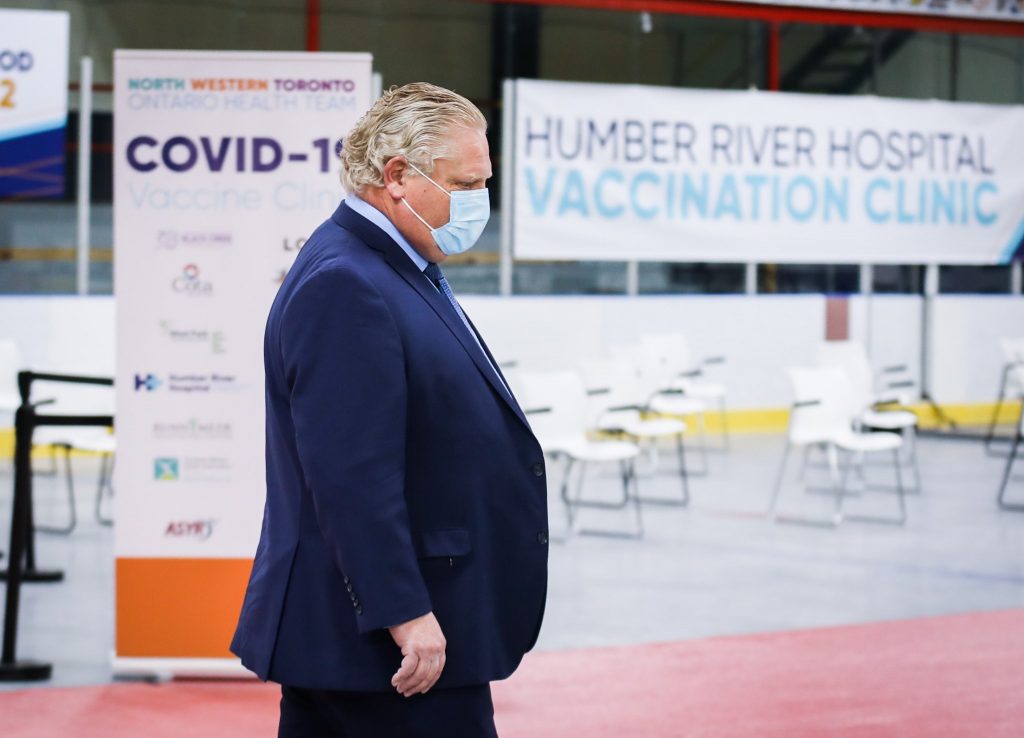Canada News
Doug Ford’s flip-flops: A dangerous failure of risk communication in COVID-19 third wave

All disasters are political.
Ontario Premier Doug Ford’s April 16 news conference announcing new pandemic control measures was followed by a rapid flip-flop after public outcry. A panicky walking back of restrictions was followed by an emotional apology six days later. But despite the honest apology, damage has already been done by what is being perceived as a lack of an informed plan.
Fifteen months into the pandemic, Canada’s most populous region is at the breaking point. Today, the COVID-19 situation in Toronto is looking more and more like that of a lesser developed nation facing a pandemic worst case scenario.
I am writing from the middle of a COVID-19 hot spot, as the spread of COVID-19 variants increases in Toronto. As a professor of disaster and emergency management, I can confirm that the view from the streets is foreboding.
Thousands of people are lining up for a chance to maybe get a vaccine at pop up clinics in neighbourhoods under threat. These hot spots are home to many of the essential workers who keep cities functioning. Reinforcements are being mustered to staff a military style field hospital set up to treat the surge of COVID-19 patients that existing hospitals will not be able to absorb.
It is now apparent that Ontario cannot vaccinate its way out of the crisis. The way out requires effective public health measures based on solid risk communications. With over one year of real-life crisis opportunities to figure out how to effectively communicate pandemic risk, why are mistakes still being made?
Distrust and inconsistent messaging
Confusion, mistrust and despair are now the predominant public attitudes in Toronto as Premier Ford first announced more restrictions and shortly thereafter walked back certain measures, like increased police powers and a ban on outdoor playground use.
Meanwhile, an increasing number of health experts are expressing the opinion that the Ford government’s failure to act quickly and decisively on dire warnings that were known months ago, has exacerbated the disaster and has ultimately cost lives.
Experts in crisis communication like Vincent Covello and Peter Sandman tell us that a major obstacle to effective risk communication is distrust. The COVID-19 risk communication situation would fall under Sandman’s category of high hazard and high outrage.
In such situations, the people receiving crisis communication are upset. The outrage is based on fear and misery rather than anger. For crisis communicators to meet the challenges, one should avoid over-reassurance, and leaders should be honest in sharing their decision-making dilemmas with the affected public.
As the third wave continues in Ontario, sentiments of mistrust are abundant. A Toronto Star editorial stated that the leadership of provincial government is “flailing about, making things up as it goes, and breaking trust with the people.” An editorial in the Washington Post called on Premier Ford to resign, suggesting he is unfit to lead Ontario though the emergency.
Bringing political shenanigans into crisis communication situations with inconsistent messaging and flip-flops is dangerous. When one directive is quickly contradicted by the next one it leaves the public indignant with all crisis communication, be it good or bad. Outrage based on misery transforms to outrage based on anger.
For example, a Toronto parent was quoted in an ABC News report saying “Ontario just closed schools days ago after insisting for weeks they were safe. The cognitive dissonance between the minister of education insisting schools are safe and then shutting playgrounds down boggles the mind.”
The need for an informed plan
Dennis Mileti, who was one of the world’s leading specialists on risk communication, told us that the basic steps for risk communication are all premised on having an informed plan. In a March 2020 interview he reflected on the pandemic crisis in the United States saying, “This might be the largest public information mess I’ve ever witnessed.” In a cruel twist of fate, he was a casualty of COVID-19.
When the province announced the sudden closure of outdoor playgrounds and then reversed course 15 hours later, the situation appeared as if Ontario did not have an informed plan. Epidemiologists tell us that outdoor COVID-19 transmission is extremely rare, especially when one observes precautions like social distancing and masking in outdoor crowds.
Risk communication issues are surrounded by political and economic overtones. As the backlash against playground closures and enhanced policing powers to enforce stay-at-home orders resulted in a dramatic reversal of COVID-19 restrictions and policies, a Pandora’s box is now open.
For the sake of fairness, why not also reverse other COVID-19 restrictions that cause a strong negative public response, like changing policy to include paid sick days with COVID-19 restrictions and reversing symbolic travel restrictions and border closures. In his April 22 apology for the previous week’s restrictions and reversal, Premier Ford suggested that the province was working toward paid sick days, but offered no details.
Public information mess
In April 2021, Ontario is facing a large public information mess that is a self-inflicted wound rooted in political ineptness. With the recent mixed messaging, a public under COVID-19 duress and a failure to apply basic risk communication principles by provincial leaders, a grim situation is exacerbated and people will die.
Now more than ever, clear and consistent provincial level pandemic risk communication is needed so we can get through this together. Without it, trust in the messages will diminish, and the public will resort to seeking whatever guidance suits them best.
Unfortunately for Ontario, we are no longer all in this together.
Jack L. Rozdilsky, Associate Professor of Disaster and Emergency Management, York University, Canada
This article is republished from The Conversation under a Creative Commons license. Read the original article.





















